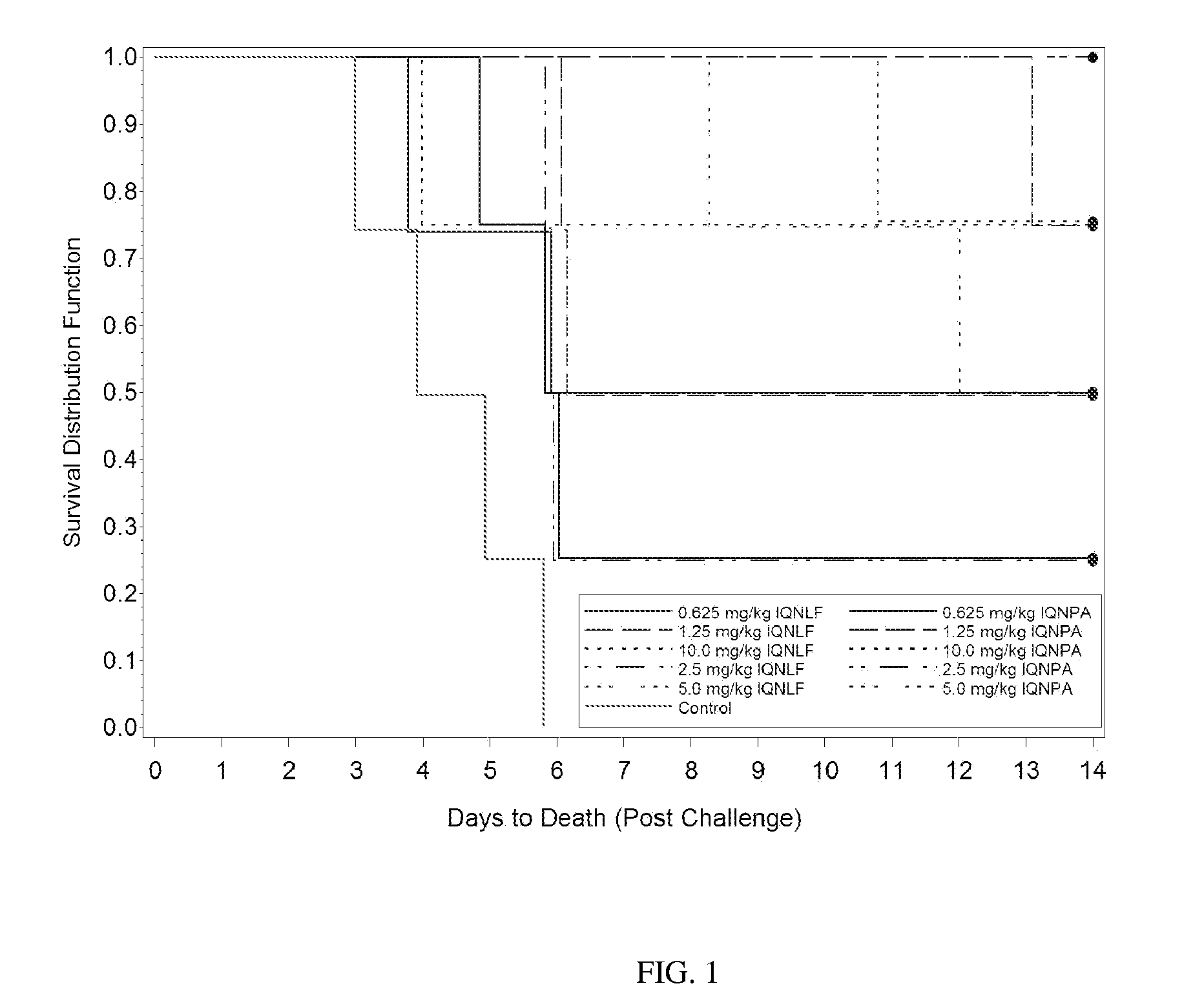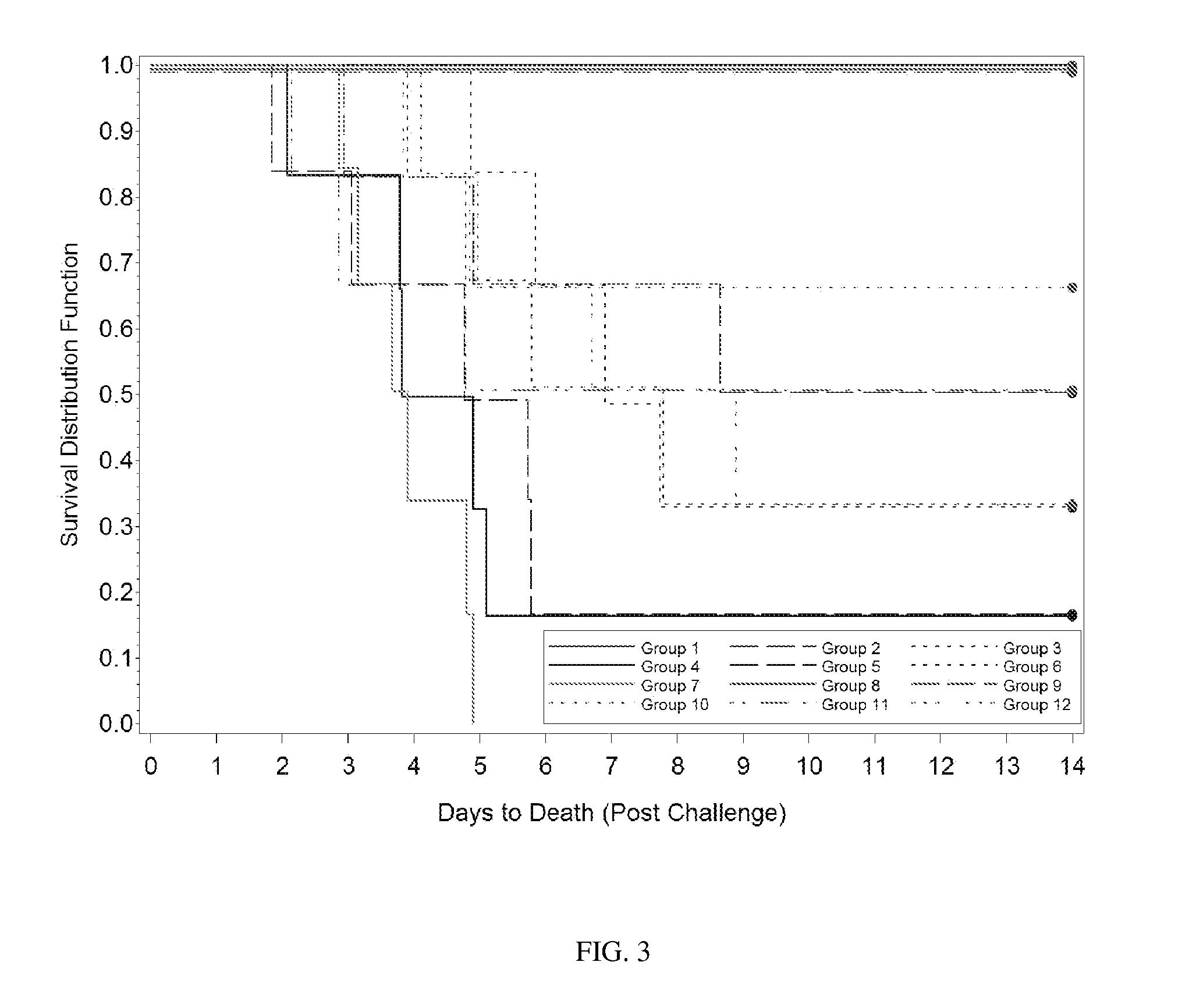Combination Antibodies For The Treatment And Prevention Of Disease Caused By Bacillus Anthracis And Related Bacteria And Their Toxins
a technology of bacillus anthracis and toxins, which is applied in the direction of antibody medical ingredients, bacterial antigen ingredients, antibody medical ingredients, etc., can solve the problems of high mortality, stridor, cyanosis and chest pain, and sudden onset of respiratory distress, so as to prolong the treatment window, increase the probability of survival, and enhance the protection against infection
- Summary
- Abstract
- Description
- Claims
- Application Information
AI Technical Summary
Benefits of technology
Problems solved by technology
Method used
Image
Examples
examples
[0128]The objective of this study was to examine the ability of two antibodies, IQNPA and IQNLF, when administered prior to exposure, to protect against death due to inhalational anthrax in New Zealand White rabbits. The average aerosol challenge dose for this study was 132±21 LD50s with a range of 99-199 LD50s. Body weight, body temperature, clinical observations, and bacteremia were all examined during the course of this study. The data, discussed in more detail below, demonstrated that both antibodies were able to prolong survival following infection with B. anthracis. Treatment did not affect the weight gain or loss seen in animals following infection, nor was there any significant change in body temperature during the course of infection (data not shown).
[0129]1.4.1 Results
[0130]1.4.1.1 Survival
[0131]Pre-treatment with either IQNLF or IQNPA prolonged survival to 5.8 and 8.12 days, respectively, on average. In the control group, the average time to death...
experiment 1
[0150]The objective of this study was to examine the ability of two antibodies, IQNPA and IQNLF, when administered after exposure to B. anthracis, either alone or in combination, to protect against death due to inhalational anthrax in rabbits. In rabbits, a body temperature increase of about 2 degrees Fahrenheit is observed at the start of the symptomatic period, which occurs about 25-29 hours post-exposure. Thus, in the following three experiments, treatment during the period of time from 0 to 24 hours following exposure is considered prophylactic treatment. Treatment after 32 hours is considered therapeutic treatment.
[0151]The average aerosol challenge dose for this study was 132±30 LD50s, with an average challenge dose of 144±28 LD50s for the first day of challenges and an average dose of 119±31 LD50s for the second day of challenges. Body weight, body temperature, clinical observations and bacteremia were all examined during the course of this study. The data, discussed in more ...
experiment 2
[0173]The main objective of this study was to further examine the efficacy of the combined treatment of IQNLF and IQNPA against inhalational anthrax infection. The target infectious dose for this study was 100 LD50s; the average aerosol challenge dose for the study was 91±27 with a range of 47-149 LD50s. The log-rank test applied to the time-to-death data showed that the pooled control group was significantly less protected than groups treated with combined antibodies when time to death was considered in addition to the overall survival rates. Overall, IQNLF alone did not provide as high a level of protection as the combined treatment.
[0174]1.6.1 Results
[0175]1.6.1.1 Survival
[0176]Fifty-seven percent (46 / 80, regardless of treatment) of the challenged animals succumbed to the infection, with an average time to death of approximately 4.08 days. For the control group, 100% (12 / 12) of animals succumbed to infection with an average time to death of 3.8 days. For Groups 1-5 (IQNLF alone a...
PUM
| Property | Measurement | Unit |
|---|---|---|
| Time | aaaaa | aaaaa |
| Dimensionless property | aaaaa | aaaaa |
| Dimensionless property | aaaaa | aaaaa |
Abstract
Description
Claims
Application Information
 Login to View More
Login to View More - R&D
- Intellectual Property
- Life Sciences
- Materials
- Tech Scout
- Unparalleled Data Quality
- Higher Quality Content
- 60% Fewer Hallucinations
Browse by: Latest US Patents, China's latest patents, Technical Efficacy Thesaurus, Application Domain, Technology Topic, Popular Technical Reports.
© 2025 PatSnap. All rights reserved.Legal|Privacy policy|Modern Slavery Act Transparency Statement|Sitemap|About US| Contact US: help@patsnap.com



